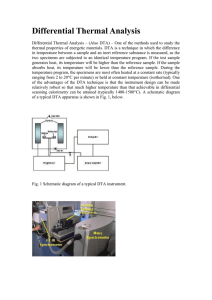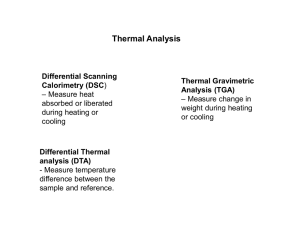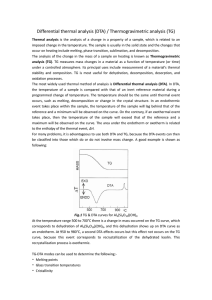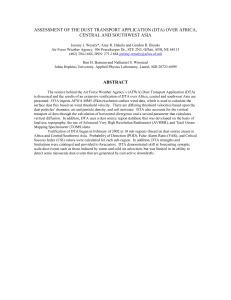Measuring AH using TG-DTA and incorporating mass
advertisement
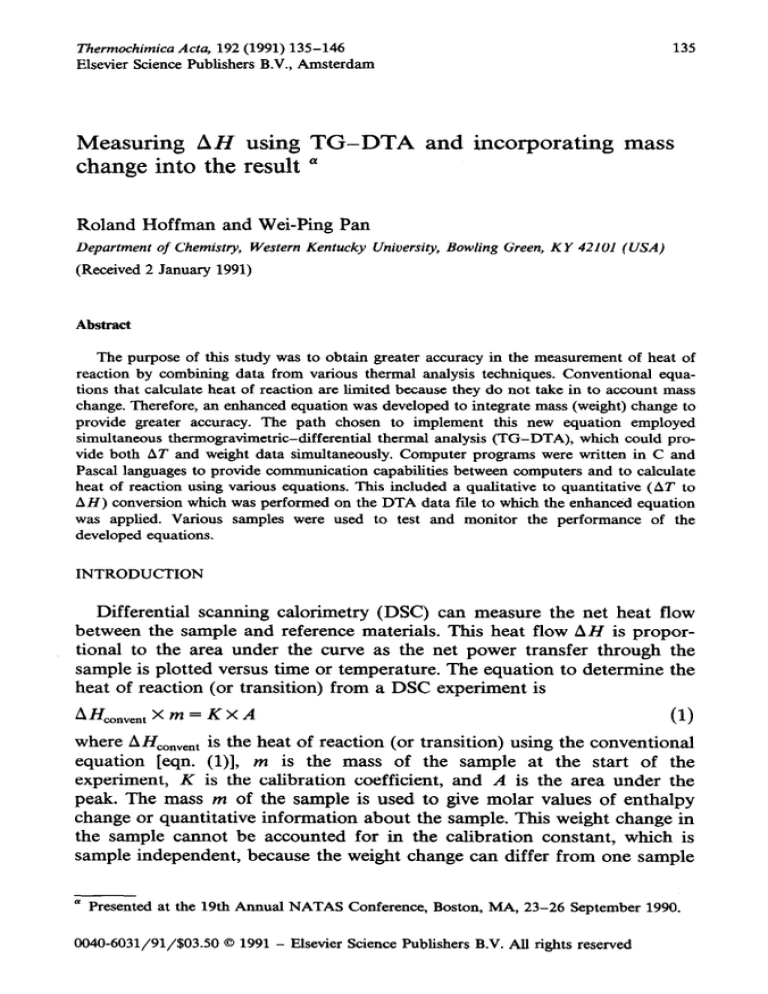
135 Thermochimica Acta, 192 (1991) 135-146 Elsevier Science Publishers B.V., Amsterdam Measuring AH using TG-DTA change into the result a and incorporating mass Roland Hoffman and Wei-Ping Pan Department of Chemistry, Western Kentucky University, Bowling Green, KY 42101 (USA) (Received 2 January 1991) Abstract The purpose of this study was to obtain greater accuracy in the measurement of heat of reaction by combining data from various thermal analysis techniques. Conventional equations that calculate heat of reaction are limited because they do not take in to account mass change. Therefore, an enhanced equation was developed to integrate mass (weight) change to provide greater accuracy. The path chosen to implement this new equation employed simultaneous tbermogravimetric-differential thermal analysis (TG-DTA), which could provide both AT and weight data simultaneously. Computer programs were written in C and Pascal languages to provide communication capabilities between computers and to calculate heat of reaction using various equations. This included a qualitative to quantitative (AT to AH) conversion which was performed on the DTA data file to which the enhanced equation was applied. Various samples were used to test and monitor the performance of the developed equations. INTRODUCTION Differential scanning calorimetry (DSC) can measure the net heat flow between the sample and reference materials. This heat flow AH is proportional to the area under the curve as the net power transfer through the sample is plotted versus time or temperature. The equation to determine the heat of reaction (or transition) from a DSC experiment is AK-?Il, Xm=KXA 0) where AH,,,, is the heat of reaction (or transition) using the conventional equation [eqn. (l)], m is the mass of the sample at the start of the experiment, K is the calibration coefficient, and A is the area under the peak. The mass m of the sample is used to give molar values of enthalpy change or quantitative information about the sample. This weight change in the sample cannot be accounted for in the calibration constant, which is sample independent, because the weight change can differ from one sample u Presented at the 19th Annual NATAS Conference, Boston, MA, 23-26 0040-6031/91/$03.50 September 1990. 0 1991 - Elsevier Science Publishers B.V. AII rights reserved 136 to another. Determination of the mass provides a means by which weight change information can be incorporated into DSC calculations. This result will be referred to as AHenhanced.The summation equation that calculates is discussed in an earlier paper [l] and will provide the dependent AHenhanced factor that is needed to compensate for any weight change sources of error in the enthalpy calculations. Differential thermal analysis (DTA) is commonly used for qualitative techniques in which characteristic data can identify corresponding temperature phase transitions by the number, the shape and the position of the various exothermic or endothermic peaks [2]. The DTA information can indirectly provide quantitative results. This can be done by multiplying the area under the curve by an experimentally calculated constant. The area generated by the differential temperature curve integration is proportional to the heat absorbed or evolved by the sample. Therefore, the heat involved AH can be expressed by the equation AH = @/“AT dt fl where $I is the proportionality constant that relates the area of the DTA curve, and t, and t, are temperature limits of the integral; AT is a qualitative term relating to AH, a quantitative result. Instrumentation for simultaneous TG and DTA can be used to provide both weight and temperature differences of the sample in a single run. The method has been so attractive for the determination of heats of reaction that the term “microcalorimeter” has been applied to the DTA instrument [3]. DTA and TGA have been used as combined techniques because thermogravimetry aids the interpretation of DTA data. Generally, there has been little agreement between the two data sets because of the variation in pyrolysis conditions. To alleviate this problem it is necessary to develop experimental conditions that are common to each analysis [4]. The development and use of simultaneous instrumentation such as TG-DSC or TGDTA would be the ideal implement to measure AHenhancedfor a compound that undergoes mass change. The simultaneous acquisition of TG and DTA data can be used to provide both weight and temperature difference of the sample in a single run. The advantage in using a TG-DTA instrument is that weight loss information can be used without the concerns that are present when combining data from separate techniques. When combining (splicing) the data files from TGA and DSC, the resulting master file can be created by selecting a parameter common to both data files and using it to match the data points from each. Time and temperature are two parameters that are common to both techniques. If time is used as the common link, the proper measures need to be taken to insure that the timetable for both systems is synchronized with 137 respect to the experiment. However, if temperature is used as the linking parameter, then steps need to be taken to insure that the temperature signal of the sample is measured in a consistent manner in both systems. In other words, the temperature signals recorded for a particular transition in each instrument must be comparable. The temperatures of DSC and TGA might not coincide in the same point in the experiment. This skewing will vary depending on the heating rate of the experiment. Previous work has been done by Elder with a Perkin-Elmer TGS-2 thermogravimetric system to determine a dynamic compensating factor for the TGA instrument so that the sample and the programmed temperature agree within f 2” C [5]. EXPERIMENTAL The Seiko instruments utilized in the study were the SSC-5040 disk station and the TG/DTA 200. The external computer used to communicate with the Seiko system was a Tatung TCS-5000 XT. The TG measurement on the Seiko system uses a horizontal differential system-balance mechanism. The sample and reference balance beams are independently supported by a driving coil/pivot. When a weight change occurs at the beam end, the movement is detected at the opposite end of the beam via the driving coil/pivot using optically positioned sensors. This signal is then sent to the balance circuit, where it supplies sufficient feedback current to the driving coil to bring the system back into balance. The current passing through the driving coils for the sample and reference beams is detected and converted into weight signals. The DTA measurement principle on the Seiko system uses two thermocouples (platinum-platinum/rhodium 13%) that are located at the end of ceramic tubes. The sample and reference pans rest on the thermocouple platform. This design allows the thermocouple to detect very accurately the temperatures of the reference and sample materials. This is the means by which the temperature difference between the sample and the reference is detected. This signal is amplified and becomes the temperature difference signal used to measure the thermal change of the sample. The furnace which encloses the sample and reference pans has a controllable heating rate, which can be varied from 0.01” C min-’ to 100.00” C mm-‘, and can attain a maximum temperature of llOO” C. Purging gas flows horizontally through the balance mechanism over the sample and exits the instrument at a maximum flow rate of 1000 ml min-i. The signals that are obtained from the Seiko system to monitor temperature are the same for TG and DTA data because the same sample and thermocouple are used in the instrument. This provides the best results, since the TG and DTA data and temperature signal are all used in the quantitative and enhanced calculations. 138 EXHIBIT 1 Temperature program Step 1 Step 2 Step 3 Range (“C) Rate (“C min-‘) Duration @in) 30.0- 80.0 80.0- 85.0 85.0-200.0 10.0 5.0 10.0 15.00 60.00 0.0 Qua+tative results cannot be obtained independently on the Seiko system because of present software constraints. However, the calculations can be done on an external computer using the data files with a program that can calculate AH,,,, and A&,,_c,. These values can then be compared with known values to endorse the integrity of the method. The parameters that were used for the thermal experiments are as follows. The mass of the sample ranged from a minimum of 10.0 mg to a maximum of 20.0 mg, which permitted us to obtain at least three significant figures. However, in a few cases, the low density of the sample meant that the sample pan was filled to more than one third full, in which case less than 10.0 mg were used. The heating rate was 10 o C min-‘. Nitrogen was used as the inert atmosphere at a flow rate of 100 ml min-I. Several quasi-isothermal conditions were set up on the heating steps for calcium sulfate hemihydrate (see Exhibit 1). RESULTS AND DISCUSSION To initiate the task of converting from qualitative to quantitative, an external computer was used to perform the necessary conversion calculation to overcome the software constraints in the Seiko system. To obtain the necessary data file from the Seiko system, a communication program was developed to transfer data files from the Seiko system to the external computer. The downloading of the data files is the first function of the communication program. Converting the data from floating point hex to ASCII is the second function of the communication program. The method in which the floating point hex is represented is shown on Table 1. The executable code of the communication program is called TALINK. The flow chart of TALINK is listed in Table 2. After the ASCII file for the TG-DTA data was created, it then became the input to the program, called DELTA, which was developed to convert DTA data from qualitative to quantitative. The flow chart of DELTA is listed in Table 3. The Seiko DTA data file contains four channels: Dl, the temperature in “C; D2, the DTA signal as PV s, where V and s are volts and seconds, respectively; D3, the thermogravimetric signal in pg; and D4, the DTG 139 TABLE 1 Floating decimal point in the TA station (internalformat) Upper Lower Address Address 76 0 76 Exponent 4 07 . : 07 0 Mantissa t-4 * Mlddle Bottom Bipolar base pomt IS 1.0, with exponent -, being Z(N-alH) Meaning of the hidden bit and sign bit: 0 if the mantissa is positive, 1 for negative 0.0 is an exception, with all bits In the mantissa and exponent Data 1.0 10.0 - 2.0 0.25 lE37 lE-37 - lE37 -lE-37 0.0 Upper addressdata being 0 l Lower addressdata (Expo_nent) (Mant. top) (Mant. mid.) (Mant. bot.) 40 42 Cl 3F 7D 03 FD 83 00 80 2d 00 80 FO 08 FO 08 00 00 00 00 00 BD 1c BD 1c 00 00 00 00 00 c2 EA c2 EA 00 signal (the derivative of the TG signal). The time parameter can be obtained by knowing the rate at which the signals were taken. The input data file of DELTA is in two parts: the header and the raw data. The header portion of the data file instructs the program as to the temperature range in which to operate, the number of approximations of n (n varies between 2 and 99) for the enhanced calculation, and the initial weight of the sample. This header is created by the user using an ASCII editor. The program DELTA uses the data file and calculates AH,,,,,, and AHdanced. An example of a command to run DELTA with the data file “mydata.dat” as input: “DELTA MYDATA.DAT”. The data file “mydata.dat”, which has the header created by the user, is used as the input to the program DELTA. The default output of the program is directed to the screen. , i n file 4 for I a I to n Get-Weight Assign delt&T. I z weight list mess[ll from header Tmelt. end Mg TI. 12. n. Read Data file telect far TGsignal bernDIe 17189s) in date Cind-TernDo 4) Find whel Temp. to Stert @~al_To-Jluanl Read Header list (Equation DELTA 7 Flow chart for the program TABLE 3 = AHenhanced + area n x mass111 n : # of approximations T2 : Final Temperatue Tl : Initial Temperature A Henhanced T-melt : Tm Mg : Initial mass of sample delta_T : AT from TG/DTA run 22 END For I = 1 to n Enhanced_Celc 142 Qf versus Temperature ..q* O 100 200 300 400 500 000 100 000 Temperature (K) Fig. 1. Graph of temperature (in K) versus Q, used to convert from AT to AH. The temperature axis is from T, for each calibration sample. The quantitative factor Q, is used in the conversion process to form a relationship between AH and AT. This technique starts with a standardization of the DTA instrument, using the manufacturer’s recommended procedure. Then, four standard metals, indium, lead, tin and zinc, are heated at 10°C rnin-’ under dynamic nitrogen gas flowing at 100 ml min-’ in open aluminum pans. At least three trials with each metal are carried out. The melting temperatures and AT values from each trial are used, in addition to the raw data file created, in the conversion calculations. The conversion from qualitative to quantitative results from the equation of the line produced by plotting Q, vs. T,,where T, is the experimental melting temperature, in K, of the metal and Q, is defined as the quantitative factor calculated from the equation A4 Qf=,, (3) where AH, is the standard heat of fusion of the calibration metals and AT is produced experimentally by finding the area of the transition of interest from the DTA instrument. The graph that was obtained by plotting Q, vs. T, canbe seen in Fig. 1. The R-squared value and the standard error of Y were calculated to be 0.970 and 0.044 respectively and the Y intercept in Fig. 1 was found to be zero (using Kelvin temperature for the X-coordinate). The relationship of Q, to our equation is important because it becomes the proportionality constant $I, as expressed in eqn. (2). However, because AT is dependent on temperature, AHconvent is found from a dependent relationship between Q, and T,;from the slope of the graph in Fig. 1 and in eqn. (4), below. Quantitative results can be obtained by inserting AT, T,,and the slope of the reaction for a material (which is in the prescribed limits of the standards used) into the general equation (4) AHc-nt = AT(slope X T,) 143 TABLE 4 A listing of AH values for various calculations Sample AH,,,t (J g-‘) Indium Tin Lead Zinc Bismuth ZnCl z LiBr LiNOs CaC,O, *H,O PI 26.6 60.7 23.0 107.7 59.8 58.7 151.0 301.7 356.9 CaC,O,*H,O Pz CaC,O,.H,O P3 CaSO,.0.5 H,O CaSO,.0.5 H,O 430.0 903.3 156.6 d 120.6 e ’ A&i, (J g-‘) 28.4 60.6 23.0 115.8 50.2 N/A 150.6 367.2 b ’ b ’ N/A N/A N/A N/A 137.2 ’ A&w,, (J g-‘) a 26.3 60.8 23.2 108.2 59.7 59.7 151.2 302.0 394.2 572.8 1641.7 163.6 d 132.2 = ’ Output from the program DELTA. b Ref. 8. ’ Ref. 9. d Programming ’ Quasi-thermal conditions. f Theoretical calculations. AHnsc.,, (J g-l> 28.5 59.4 22.8 114.0 51.3 64.8 151.9 325.5 N/A N/A N/A 168.9 d 123.8 e at 10°C mir-‘. The slope of this equation can provide the needed relationship to convert qualitative results to quantitative. However, the value of this slope, which is 0.00258, is only valid for the experimental conditions in which it was obtained. A new slope would be required if experimental conditions changed. Table 4 shows the list of samljles and various AH values, where AHr,sc,~XP represents DSC experimental results, AHconventrepresents the value of AH calculated by conventional equation [eqn. (l)], A HLit represents AH values from cited sources, and AHdad is the AH value calculated from the enhanced equation discussed in a previous paper [a]. A conversion of AT to AH was performed on each of the samples in Table 4. The values of were calculated by using the program DELTA. These AHc0ll”~ntand AHe.lIhanced values are the quantitative and the enhanced values applied to the DTA data files, respectively. The expected values between A Hconventand AHenhanced should not be significantly different for those samples that do not undergo a mass change during the experiment. This is demonstrated for indium, tin, lead, zinc, bismuth, and lithium bromide. Although there are some differences between AH,,ve,t and AHenhad for these samples, the differences are within the experimental error. A comparison can also be made between AH,,,,, 9 the literature value, A HLit, and the DSC experimental value, As can be observed on Table 4, values for the metals from AHrXc.,,. indium to bismuth show a high positive correlation one to another. From this correlation it can be said that the qualitative to quantitative conversion equations are reliable and can be utilized within the limits of calibration. Calcium oxalate monohydrate has three decomposing transitions, and mass is lost in every transition. Nevertheless, the conventional calculations‘, 144 which do not take this into consideration, diverge away from the heat flow that is taking place per amount of sample left in the cell. When AH is calculated conventionally, it is divided by the initial mass of the sample. If the sample changes mass during the experiment, then what is left in the cell does not produce the same unit of activity as the conventional calculations reflect. In other words, when there is mass loss and a endothermic reaction, as with calcium oxalate monohydrate, the conventional results are lower than expected because less mass is involved than is involved in the calculation. Conventional calculations assume that the initial mass is the amount involved throughout the entire experiment. The effect of this assumption is amplified in the successive transitions for calcium oxalate monohydrate. An increase in the differences between AHanvent and AHenhand is observed from peak 1 to peak 3 in Table 4. The percentage differences in peak 1, peak 2 and peak 3 are 9.5, 24.3 and 45.0, respectively. An increasing difference is what should be expected, because the mass change is cumulative for successive transitions. To establish the integrity of the enhanced calculations, a comparison was made between theoretical values obtained from the program output [7] and the results from a TG-DTA and DSC experiment on calcium sulfate hemihydrate. When a comparison is made between AHenhancedin quasi-thermal conditions and AHLit for calcium sulfate hemihydrate, on Table 4, it is observed <Sample> CeSO4dHZO 11 700 TG/DTA cNeme> ( II 700 <Reference> cOate> Hoff 29 69/09/07 17 00 <Temp programlC1 1+ 30.060.0 Prog#G mgl mg NZ ---------______ --_-__-___-____ at 100 cc/M -------___-____ A1203 14.200 240 <Comment> mg 5s cSampltng> 0.5 set 3. a5 o- 200.0 2e 60.085.0 <Gas, N2 -______________ IC/minl IO 00 10.00 5 O0 [mini> 15.00 "::z 100 0 mllmln 0 0 mllmtn 101 99 97 I F 95 30Seiko -4.5 Instruments 0 23.2 Inc TIME 46.4 min 69.59 92.79 Fig. 2. TG-DTA heating curve: CaSO,.O.S H,O in quasi-thermal conditions. 83 145 that AHenhancedis 5 J g-l units smaller than AHLit. This is due partly to the fact that the loss of mass due to dehydration was not fully accounted for in the DTA curve. A ‘loss of a half of a mole of water from calcium sulfate hemihydrate represents 6.2% of the total weight of the sample. The results of DTA measured only 89% of the molar dehydration from calcium sulfate hemihydrate, Fig. 2. This would account for the lower AHenhanced value compared with theoretical. The experimental conditions are quasi-thermal, which means that the loss of water from the sample does not occur at a constant temperature. However, the calculations for calcium sulfate hemihydrate were confined only to the portion of the experiment where hydrated water was evaporating and the heating rate was O°C min-‘. This would cause an additional deviation to the results. However, more work can be done by addressing the effects of Q, when the heating or flow rate is varied. It becomes increasingly important to address the insignificant causes of error each time technology allows us to make that next step toward the exact energies that are involved in these measuring methods of thermodynamics. Nevertheless, in these experiments, the enhanced equations do indeed come close to the theoretical values, and should be considered for use when the analyst is interested in approaching the exact energies that are produced or consumed in the sample. CONCLUSIONS 1. Qualitative to quantitative conversions can be performed using the Seiko TG/DTA 200 system. 2. The results from the enhanced equations can provide AH values that are independent of the weight change of the material. RECOMMENDATIONS 1. The accommodation of the enhanced equations in all TG-DSC and TG-DTA instruments should be an available option. 2. Find Q, for 0” C min-’ heating rate. This could be done by solving for Q, at various heating rates and extrapolating the data to a heating rate of 0°C min-l. ACKNOWLEDGEMENTS We thank Seiko Instruments, USA for their past and continuing on our behalf at Western Kentucky University. support REFERENCES 1 R. Hoffman and Wei-Ping Pan, Thermochim. Acta, 166 (1990) 251. 2 W.W. Wendlandt, Thermal Methods of Analysis,, Wiley, New York, 3rd edn. 1964, p. 134. 146 3 4 5 6 M. Wittels, Am. Mineral., 36 (1951) 23. Ref. 2, p. 178. J.P. Elder, Thermocbim. Acta, 52 (1982) R. Hoffman, Measuring AH using DSC, University, 1990, p. 7. 7 R. Hoffman, Measuring AH using DSC, University, 1990, Table 10, p. 41. 8 Ref. 2, p. 276. 9 CRC Handbook, 66th edn., B-230, CRC 235. TGA and DTA, MS. thesis, Western Kentucky TGA and DTA, M.S. thesis, Western Kentucky Press, Boca Raton, FL, 1986.
